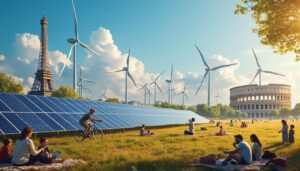An energy-consuming dwelling refers to a home whose energy consumption significantly exceeds what is necessary to ensure optimal comfort. Often called a thermal sieve, this inefficiency results from poor insulation, leading to a significant loss of heat or coolness depending on the seasons. A less than flattering energy performance diagnosis, characterized by classes ranging from E to G, generally indicates these energy-consuming homes. High energy bills, a damp indoor atmosphere, and discomfort are all telltale signs that a dwelling consumes more energy than it should.
An energy-consuming dwelling, also known as a thermal sieve, refers to a home that has excessive energy consumption, well beyond what is required to maintain optimal comfort. This overconsumption is primarily caused by poor insulation, resulting in significant heat losses and major energy wastage. In such an environment, residents often experience a damp and uncomfortable atmosphere, both in summer and winter.
Energy-consuming dwellings are generally classified in the lowest categories of the energy performance diagnosis (EPD). This classification, ranging from A to G, indicates that energy-consuming homes fall between classes E and G. These homes consume more than 330 kWh/m²/year, with some consumption exceeding 450 kWh/m²/year.
The telltale signs of an energy-consuming dwelling include high energy bills and poor thermal performance. These homes are often poorly insulated, allowing heat to escape, thus necessitating increased use of heating systems in winter and air conditioning in summer. The use of aging and energy-consuming appliances also contributes to this overconsumption.
The consequences of living in an energy-consuming dwelling are twofold: on one hand, it leads to additional expenses due to higher energy bills, and on the other hand, it has a negative impact on the environment as these homes often use non-renewable energy sources.
To counter this situation, various solutions can be implemented. Improving insulation, modernizing heating systems, and choosing more energy-efficient appliances are crucial steps to reduce a building’s energy footprint. Furthermore, it is possible to turn to energy certifications that guide towards concrete improvements.
For instance, consider the expansion of green hydrogen, which offers innovative solutions for renewable energy. By evolving towards such sustainable sources, homes can drastically reduce their non-renewable energy consumption.
It is important to note that addressing the issue of energy-consuming homes fits within a broader approach to energy transition. This transition aims to reduce our dependence on fossil fuels and lower our grey energy, which is the hidden energy consumed by manufactured goods before they are made available to the consumer.
Finally, in the face of current climate challenges, improving the energy efficiency of homes represents not only a crucial step to reduce greenhouse gas emissions, but it is also an opportunity to adapt to climate change, while promoting innovative and sustainable renovation solutions. Addressing energy-consuming homes means actively participating in a transition towards a more sustainable future.

FAQ: Understanding Energy-Consuming Dwellings
Q : What is an energy-consuming dwelling?
A : An energy-consuming dwelling, also called a thermal sieve, is a home that consumes an excessive amount of energy, primarily due to poor insulation. This leads to overconsumption of energy for heating, cooling, and hot water.
Q : What are the signs indicating that a dwelling is energy-consuming?
A : Certain signs are unmistakable, such as an unpleasant damp atmosphere indoors, poor thermal performance, and overconsumption of energy. A poor score on the energy performance diagnosis (EPD) is also revealing.
Q : How does the energy performance diagnosis (EPD) help identify an energy-consuming dwelling?
A : The EPD classifies dwellings from A to G based on their energy consumption. Dwellings classified from G to E, meaning consuming between more than 450 kWh/m²/year and 330 kWh/m²/year, are considered energy-consuming.
Q : Why are energy-consuming dwellings also called thermal sieves?
A : These dwellings are called thermal sieves because they allow heat to escape due to poor insulation, which unnecessarily increases energy consumption.
Q : What solutions can be envisaged to improve an energy-consuming dwelling?
A : To transform an energy-consuming dwelling, improvements such as better insulation, installing more efficient heating systems, or utilizing renewable energy sources like solar energy are recommended.
Q : What are the economic consequences of an energy-consuming dwelling for its occupants?
A : An energy-consuming dwelling leads to increased energy bills, which can heavily weigh on the occupants’ budget due to additional heating and cooling expenses.
Articles similaires
Thank you!
We will contact you soon.













